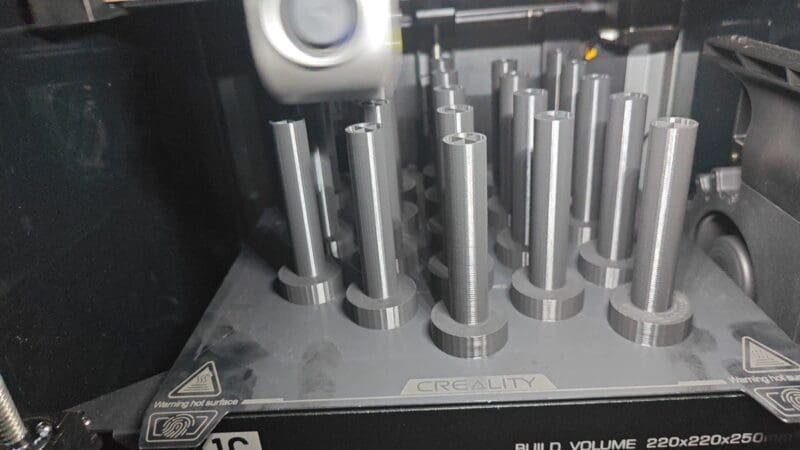How to Fix Brittle Filament?

3D printing has transformed prototypes and product creation. But when the filament snaps or is brittle, it can be frustrating. The brittle filament can lead to a variety of issues throughout the printing process, resulting in mistakes in the final output or even harm to the printer. For printing to go well and to prevent these problems, it’s crucial to understand how to fix brittle filament. In this article, we’ll talk about what brittle filament is, how it happens, how to avoid it, and how to treat it.
What is Brittle Filament
A type of filament known as the brittle filament is prone to cracking or breaking while being printed or even when being stored. Many amateurs and experts who use 3D printing encounter this problem frequently. The issue of brittle filament can affect a variety of filament types, including PLA, ABS, PETG, and Nylon.
The brittle filament can be identified by the following symptoms:
- the filament looks to be dry and discolored
- the filament snaps easily when bent or twisted –
the filament breaks during printing, resulting in open gaps in the printed object - the filament makes a cracking sound during printing
Brittle Filament Causes
Environmental conditions, filament quality, and printer settings are just a few of the many causes of filament brittleness.
Temperature and humidity are two environmental factors that can significantly affect the quality of your filament. If your filament is exposed to high amounts of humidity, it may absorb moisture, which could make it brittle, especially if it is kept for a long time. Similar to this, brittleness can result from storing your filament in a hot environment.
The filament’s quality is a further factor that could cause brittle filament. Poorer quality filaments may be more vulnerable to breaking, particularly if kept in storage for a long time or exposed to environmental influences.
The brittle filament can also be caused by printer calibration and settings. The filament may snap or break while printing if your printer is not calibrated properly, which will result in faults in the created product. Similar to the last example, brittleness can result from improper or excessive heating of the filament in your printer.
How to Fix Brittle Filament?
You can use filament dryers, calibrate and change the settings on your printers, and store your filament properly to repair brittle filament.
The brittle filament can be avoided and fixed with proper filament storage. Your filament may crack if it is not stored properly, especially if it is exposed to environmental elements like light, heat, and humidity. The best place to keep filament stored is somewhere cool and dry, like a storage container or a sealed bag with a desiccant to absorb moisture.
The brittle filament can also be fixed by calibrating and adjusting printer parameters. To avoid the filament overheating and becoming brittle, you can change the temperature settings on the printer. Additionally, you may alter the print speed and nozzle height to guarantee that the filament is properly extruded, lowering the possibility of snaps and breaks.
The brittle filament can be fixed and prevented with the use of filament dryers. They are made to dry out the filament, making it less brittle and better in every way. They function by raising the temperature of the filament, which causes the moisture to evaporate.
Concluding
An annoying problem that can occur with 3D printing is a brittle filament, which can harm the printer and result in mistakes in the printed object. Understanding the primary causes of brittle filament is essential for preventing and resolving the issue. Effective solutions to this issue include proper filament storage, printer calibration, and the use of filament dryers. You may guarantee a flawless printing process and the highest-quality final items by following these instructions.
FAQ
What exactly is a brittle filament?
A type of 3D printing filament called brittle filament is one that readily snaps, cracks, or breaks while being printed or while being stored.
What results in the brittleness of filament?
High humidity and temperature in particular can cause filaments to absorb moisture and become brittle. Brittleness can also be caused by poor printer settings and low-quality filaments.
How can I tell whether the filament I have is brittle?
Discoloration, snapping readily when bent or twisted, breaking during printing, and making a cracking sound are some symptoms of brittle filament.
Can I still 3D print using brittle filament?
The brittle filament should not be used for 3D printing as it may result in mistakes in the final product and printer damage.
How do I stop the filament from breaking?
Desiccant use and proper filament storage in a dry, cool environment can stop filament from accumulating moisture and hardening. Brittleness can also be avoided by utilizing high-quality filament and performing routine printer maintenance.
Is there a repair for the brittle filament?
The brittle filament can be fixed by proper filament storage, printer calibration and setting adjustments, and the use of filament dryers.
Are all filaments susceptible to brittleness?
No, filaments are not all prone to brittleness. However, typical filaments that are prone to brittleness include PLA, ABS, PETG, and nylon.
Can brittle filament be recycled?
Reusing brittle filament is not advised because it can cause more printing problems and harm to the printer. The brittle filament should be thrown away, and new filament should be used instead for printing.
DISCLOSURE: THIS POST MAY CONTAIN AFFILIATE LINKS, MEANING I GET A COMMISSION IF you DECIDE TO MAKE A PURCHASE THROUGH MY LINKS, AT NO COST TO YOU. PLEASE READ MY DISCLOSURE FOR MORE INFO.






